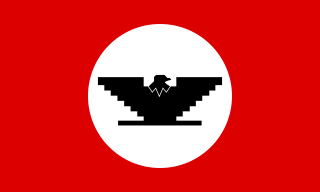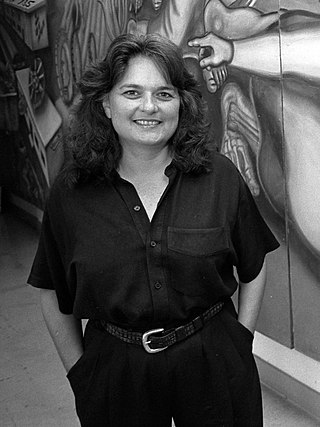
Chicano or Chicana is an ethnic identity for Mexican Americans that emerged from the Chicano Movement. Chicano was originally a classist and racist slur used toward low-income Mexicans that was reclaimed in the 1940s among youth who belonged to the Pachuco and Pachuca subculture.

A lowrider or low rider is a customized car with a lowered body that emerged among Mexican American youth in the 1940s. Lowrider also refers to the driver of the car and their participation in lowrider car clubs, which remain a part of Chicano culture and have since expanded internationally. These customized vehicles are also artworks, generally being painted with intricate, colorful designs, unique aesthetic features, and rolling on wire-spoke wheels with whitewall tires.
The Mission District, commonly known as the Mission, is a neighborhood in San Francisco, California. One of the oldest neighborhoods in San Francisco, the Mission District's name is derived from Mission San Francisco de Asís, built in 1776 by the Spanish. The Mission is historically one of the most notable centers of the city's Chicano/Mexican-American community.

East Side San Jose, commonly called The East Side and less commonly as the East Valley, is the eastern region of the city of San Jose, California. The East Side is made up of numerous neighborhoods grouped into two larger districts: Alum Rock and Evergreen. East San Jose is bordered by the Diablo Range to the east and south, the Coyote Creek to the west, and Mabury Road to the North.

A lowrider bicycle is a highly customized bicycle with styling inspired by lowrider cars. These bikes often feature a long, curved banana seat with a sissy bar and very tall upward-swept ape hanger handlebars. A lot of chrome, velvet, and overspoked wheels are common accessories to these custom bicycles.

The Royal Chicano Air Force (RCAF) is a Sacramento, California-based art collective, founded in 1970 by Ricardo Favela, José Montoya and Esteban Villa. It was one of the "most important collective artist groups" in the Chicano art movement in California during the 1970s and the 1980s and continues to be influential into the 21st century.

Chicano Park is a 7.9 acres (32,000 m2) park located beneath the San Diego–Coronado Bridge in Barrio Logan, a predominantly Chicano or Mexican American and Mexican-migrant community in central San Diego, California. The park is home to the country's largest collection of outdoor murals, as well as various sculptures, earthworks, and an architectural piece dedicated to the cultural heritage of the community.
José Antonio "Tony" Burciaga was an American Chicano artist, poet, and writer who explored issues of Chicano identity and American society.

The Centro Cultural de la Raza is a non-profit organization with the specific mission to create, preserve, promote and educate about Chicano, Mexicano, Native American and Latino art and culture. It is located in Balboa Park in San Diego, California. The cultural center supports and encourages the creative expression “of the indigenous cultures of the Americas.” It is currently a member of the American Alliance of Museums.
Gilbert "Magu" Luján was a Chicano American sculptor, muralist, painter, and educator. He was a founding member of the Chicano collective, Los Four that consisted of artists Carlos Almaraz, Beto de la Rocha, Frank Romero and himself. In 1974, Judithe Hernández became the "fifth member," and only female member of Los Four.

Judith Francisca Baca is an American artist, activist, and professor of Chicano studies, world arts, and cultures based at the University of California, Los Angeles. She is the co-founder and artistic director of the Social and Public Art Resource Center (SPARC) in Venice, California. Baca is the director of the mural project that created the Great Wall of Los Angeles, which was the largest known communal mural project in the world as of 2018.

Galería de la Raza (GDLR) is a non-profit art gallery and artist collective founded in 1970, that serves the largely Chicano and Latino population of San Francisco's Mission District. GDLR mounts exhibitions, hosts poetry readings, workshops, and celebrations, sells works of art, and sponsors youth and artist-in-residence programs. Exhibitions at the Galería tend to feature the work of minority and developing country artists and concern issues of ethnic history, identity, and social justice.
Salvador Roberto Torres is a Chicano artist and muralist and an early exponent of the Chicano art movement. He was one of the creators of Chicano Park, and led the movement to create its freeway-pillar murals. He was also a founder of the Centro Cultural de la Raza in San Diego, California.

The Chicano Art Movement represents groundbreaking movements by Mexican-American artists to establish a unique artistic identity in the United States. Much of the art and the artists creating Chicano Art were heavily influenced by Chicano Movement which began in the 1960s.

Yosimar Reyes is a Mexican-born poet and activist. He is a queer undocumented immigrant who was born in Guerrero, Mexico, and raised in East San Jose, California. Reyes has been described as "a voice that shines light on the issues affecting queer immigrants in the U.S. and throughout the world."
Josephine S. "Josie" Talamantez is a historian from San Diego, California. She co-founded Chicano Park in 1970 and helped develop it into a cultural National Historic Landmark containing the largest collection of artistic murals in the United States. Talamantez was also the Chief of Programs for the California Arts Council, served as the director of the Centro Cultural de la Raza, and was on the board of the National Association of Latino Arts and Culture.
A Mexican American is a resident of the United States who is of Mexican descent. Mexican American-related topics include the following:
This is an alphabetical index of topics related to Hispanic and Latino Americans.

Mayfair is a neighborhood of San Jose, California, located in the Alum Rock district of East San Jose. It is one of San Jose's most historic Chicano/Mexican-American districts and noted for being a center of the Chicano Movement and grassroots activists such as Californian civil rights leader César Chávez.

A Chicano mural is an artistic expression done, most commonly, on walls or ceilings by Chicanos or Mexican-American artists. Chicano murals rose during the Chicano art movement, that began in the 1960, with the influence of Mexican muralism and the Mexican Revolution. The murals are an illustration of Chicano’s ethnic pride or a form of activism against police brutality, social issues, political issues, and civil rights issues. It started being done by young Chicano artists in commonly marginalized neighborhoods, schools, and churches, demonstrating cultural art and ideas. The murals are characterized by their art style of bright color, religious symbols, and cultural references to Mexican and Mexican American history. Chicano murals have been and are historically found in the Southwest states like Texas, Colorado, and most famously, California, where the national landmark Chicano Park is located. The popularity of the Chicano Murals has allowed a sense of community, culture, activism, and storytelling about elements of being Chicano. Various states are currently looking to preserve and restore some murals as they carry historical meaning for the geographical community and the Mexican-American community.

























